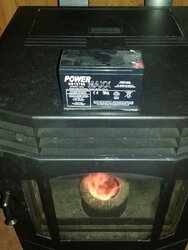$35 a day in fuel is absurd... get a small 1000 watt jobber in pure sine. run your stove, some lights, swap the frige on and off with something else.
sip less than a gallon a day.
A long reply here, but it might give other entrepreneurs or telecommuters who need to stay "up and running" some ideas. Just skip it if you don't care to read it...
A 1000 watt gennie and a couple of extension cords or a little transfer switch is fine if you want to just rough out the occassional outage in suburbia when you come home from work, but it doesn't quite cut it for all of us. I don't know where you go to work every day, but I go down two floors to my office. Between that and the house, there are two pellet stoves, two fridges, a well and a septic system with pumps. We actually live not that far out from "civilization", but it is on a road with only 7 houses on it, and when you hear about "only a few homes still without power" there's a good chance we're one of them. And if I'm not working, I'm not generating revenue - and that's a bad thing I try to avoid.
My backup system with the batteries and $35 in daily fuel cost during an outage means that the gigabit router and switches, connected to the FIOS interface and its tiny little battery, never loses power, even with us pumping lots of data through it each day and during loss of utility power, generator startup, refueling, etc. That's important because if it does lose power it will become a brick until it reconnects with Verizon, and that can take hours or, if they're having problems, longer (they are on battery and generator setup similar to my own, just much bigger, and have never gone down - really like those FIOS folks). See part about not generating revenue, much less potential client dissatisfaction, and you start to get the picture.
My system allows me to spend less than 5 minutes firing up the gennie and switching over to that for power (and again, without the computers or internet connection going down) but without the cost of an automatic generator, which would require installation of a large propane tank. It also makes sure critical systems keep chugging along even if power goes out while we're sleeping, I can handle 8000 watts continuous, 12000 peak (surge), although we rarely approach either but are far more than the 1000 watts mentioned. Refueling is done in the evening from reserve tanks, so if I start with a full tank in the gennie I can go 4 days without power and before I need to go out for fuel, and I suppose then I could access the gas in the cars if necessary and go just over a week. Gas is treated with stabilizer and moved out to cars and equipment each spring and fall if not used. And we also retain the ability to take nice hot showers, watch TV, and generally go about our lives without missing a beat and having a 15 second commute, all for $35 a day IF the power goes out.
So it ain't all that absurd, and it simply thrashes my lifestyle prior to figuring this out somewhere in mid-career. Best $35 I ever spent, when it's needed!


